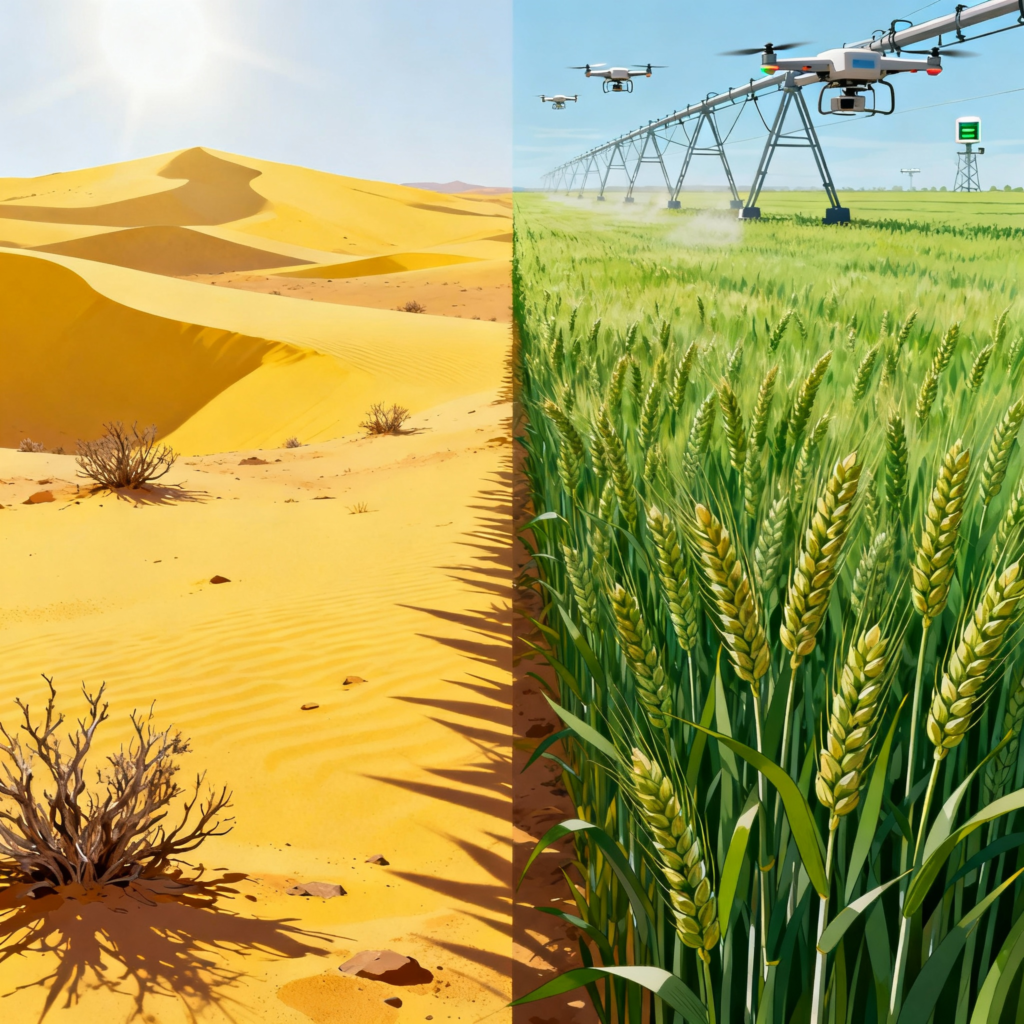Key Highlights
- Desert-to-Farm Transformation: CUoR researchers successfully converted barren Thar desert sand into productive wheat farmland yielding 260kg from 13kg seeds (1:20 ratio), double the output of conventional desert agriculture
- Water Conservation Breakthrough: Soilification technology reduces irrigation cycles from 5-6 to just 3 cycles, achieving 40-50% water savings while maintaining higher crop productivity in water-scarce arid regions
- National Scale Crisis: India faces 30.51 million hectares of degraded land (9.45% of total area) with Rajasthan leading at 21.2 million hectares, threatening NCR as Thar desert expands eastward
- Multi-Crop Validation: Laboratory trials demonstrate 54% higher yields across diverse crops including bajra, guar gum, and chickpea, proving technology’s broad applicability beyond wheat production
- Indigenous Innovation: Bioformulation uses locally available bio-agents and simple application techniques without heavy machinery, making the low-cost technology accessible to small-scale farmers
India’s battle against desertification has reached a critical juncture, with 30.51 million hectares of degraded land – representing 9.45% of the country’s total area – posing an existential threat to agricultural sustainability and food security. The Thar Desert’s relentless expansion toward the National Capital Region (NCR) has become a pressing concern for policymakers and environmental scientists, threatening millions of livelihoods and ecological balance.
In a groundbreaking development that could transform India’s approach to desertification control, researchers at the Central University of Rajasthan (CUoR) have successfully demonstrated revolutionary “soilification” technology that converts barren desert sand into productive agricultural land. This indigenous biotechnology innovation achieved remarkable results in Banseli village, Ajmer district, where 13 kg of wheat seeds yielded an unprecedented 260 kg harvest from just 1,000 square meters of treated desert land.
The timing of this breakthrough is particularly crucial as over 120 million hectares – more than one-third of India’s land area – currently experience drought conditions, while 18% of the population faces direct exposure to land degradation impacts. This innovative technology offers hope for millions of farmers in arid and semi-arid regions where traditional agriculture has become increasingly unsustainable due to climate change, soil erosion, and water scarcity. global-agriculture
Understanding Desertification Crisis
Scope and Scale of Land Degradation
Desertification – the degradation of land in arid, semi-arid, and dry sub-humid areas due to climatic variations and human activities – has emerged as one of India’s most pressing environmental challenges. The problem extends far beyond the obvious desert regions, affecting 21 states and union territories with varying degrees of severity.
Rajasthan leads the affected regions with 21.24 million hectares of degraded land, followed by Maharashtra (14.31 million hectares) and Gujarat (10.25 million hectares). These statistics represent not just environmental degradation but the erosion of agricultural productivity that supports hundreds of millions of rural livelihoods.
Primary Causes and Drivers
The multifaceted nature of India’s desertification crisis stems from both natural and anthropogenic factors. Water erosion accounts for 80% of degradation on unirrigated, rainfed farmland, particularly during heavy monsoon events that wash away precious topsoil. Over half of India’s farmlands depend on rainfall rather than irrigation, making them particularly vulnerable to extreme weather events.
Human activities significantly accelerate the degradation process through overgrazing, deforestation, poor irrigation practices, and intensive agriculture that depletes soil nutrients. The degradation of Aravalli ranges, combined with unscientific plantation drives and changes in rainfall patterns, has intensified sand dune spread toward populated areas.
Climate change impacts have exacerbated these challenges through erratic precipitation patterns, increased frequency of droughts, and rising temperatures that stress both soil and vegetation systems. These factors create a vicious cycle where degraded land becomes increasingly susceptible to further deterioration.
Impact on Agriculture and Rural Livelihoods
The socioeconomic consequences of desertification extend far beyond environmental degradation. Agricultural productivity declines dramatically in affected areas, forcing farmers to abandon traditional crops or migrate to urban centers. Food security concerns intensify as productive agricultural land shrinks while population and food demand continue growing.
Rural communities in desert-prone areas face water scarcity, reduced crop yields, and loss of traditional livelihoods dependent on agriculture and animal husbandry. The economic burden of land degradation affects not just individual farmers but entire regional economies dependent on agricultural output.
Revolutionary Soilification Technology
Scientific Breakthrough and Methodology
The soilification technology developed by Central University of Rajasthan represents a paradigm shift in desert reclamation approaches. Led by Professor Akhil Agrawal from the Department of Microbiology and executed by research scholar Diksha Kumari, the project demonstrates how indigenous bioformulations and polymers can transform loose desert sand into a soil-like structured medium suitable for agriculture.

The core mechanism involves cross-linking sand particles using specialized polymers while bioformulations enhance microbial activity essential for nutrient cycling and soil health. This process creates a binding effect that dramatically improves water retention and reduces irrigation requirements – critical factors for sustainable agriculture in water-scarce regions.
Remarkable Field Trial Results
The pilot wheat cultivation in November 2024 using Wheat-4079 variety yielded extraordinary results that exceeded all expectations. The 1:20 seed-to-harvest ratio (13 kg seeds producing 260 kg wheat) represents double the output achieved on untreated desert land using conventional methods.
Water conservation emerged as a particularly significant benefit, with treated land requiring only 3 irrigation cycles compared to 5-6 cycles needed for conventional wheat farming. This 40-50% reduction in water usage addresses one of the most critical constraints facing agriculture in arid regions.
Laboratory trials on multiple crops including bajra, guar gum, and chickpea demonstrated 54% higher yields on bioformulation-amended sand compared to untreated controls. This broad applicability suggests the technology’s potential for diverse cropping systems beyond wheat production.
Technological Innovation and Scalability
The soilification process utilizes locally available bio-agents and simple application techniques that don’t require heavy machinery or complex infrastructure. This low-cost, eco-restorative approach makes the technology accessible to small and marginal farmers who constitute the majority of India’s agricultural workforce.
Stress resistance enhancement enables crops to tolerate heat and arid conditions that would normally prevent successful cultivation. The technology essentially creates a conducive microenvironment within harsh desert conditions, allowing plants to establish and thrive where they previously couldn’t survive.
Stakeholder Ecosystem and Collaborative Framework
Research Institution Leadership
Central University of Rajasthan (CUoR) serves as the primary research institution driving this technological innovation, with the Department of Microbiology providing specialized expertise in bioformulation development. The university’s location in desert-prone Rajasthan provides ideal conditions for field testing and real-world validation of the technology.
Krishi Vigyan Kendra (KVK) plays a crucial role in layout planning and scaling of field trials, ensuring that research findings translate into practical applications for farmers. KVKs’ extensive network across India provides potential pathways for technology dissemination once proven successful.
Rajasthan Horticulture Department facilitates field implementation and provides institutional support for scaling up successful trials. This multi-institutional collaboration ensures that research advances receive adequate policy and administrative backing for broader deployment.
Farmer Communities and Local Participation
Local farmers in Banseli village and surrounding areas serve as crucial partners in technology validation and refinement. Their traditional knowledge combined with scientific innovation creates a powerful partnership for developing contextually appropriate solutions.
Community-based organizations and farmer producer groups can facilitate technology adoption and knowledge sharing among rural communities. These organizations often possess social capital and trust networks essential for successful technology transfer.
Government Agencies and Policy Framework
Ministry of Agriculture and Farmers Welfare oversees national agricultural policies that could support large-scale adoption of successful desert farming technologies. Existing schemes like Pradhan Mantri Krishi Sinchai Yojana and National Mission for Sustainable Agriculture provide potential integration pathways.
Ministry of Environment, Forest and Climate Change coordinates national anti-desertification efforts through programs like the Desert Development Programme and National Action Programme to Combat Desertification. These existing frameworks could incorporate successful technological innovations into broader policy initiatives.
State governments, particularly Rajasthan, play critical roles in policy implementation and resource allocation for scaling up promising technologies. State-level agricultural departments and rural development agencies serve as key implementation partners.
International Organizations and Support
United Nations Convention to Combat Desertification (UNCCD) provides international frameworks and technical support for national anti-desertification efforts. India’s commitment to achieve Land Degradation Neutrality by 2030 creates policy imperatives for adopting effective technologies.
International agricultural research centers and development agencies offer potential partnerships for technology refinement and scaling support. These collaborations can provide additional funding, technical expertise, and global best practices for desert reclamation.
Implementation Challenges and Critical Considerations
Technical and Operational Constraints
Site-specific limitations represent a significant challenge, as soil conditions, climate patterns, and water availability vary dramatically across India’s diverse agro-climatic zones. What works effectively in Rajasthan’s desert conditions may require substantial modifications for success in other regions.
Scaling from pilot to commercial applications presents logistical complexities including quality control of bioformulations, training farmer communities, and establishing supply chains for necessary inputs. Maintaining consistency across different implementation sites requires standardized protocols and quality assurance mechanisms.
Long-term monitoring remains essential to assess technology durability and environmental impacts over multiple cropping seasons. Initial success doesn’t guarantee sustained performance, particularly under varying weather conditions and different management practices.
Economic and Financial Barriers
Upfront investment costs for bioformulation application and farmer training may exceed immediate financial capacity of target communities. Even low-cost technologies require initial capital investment that many marginal farmers cannot afford without external support.
Risk perception among farmers accustomed to traditional practices may slow adoption despite demonstrated benefits. Financial losses from failed experiments can devastate small farming families, creating natural resistance to new technologies.
Market linkages and price support for crops produced using new technologies need establishment to ensure economic viability for adopting farmers. Higher production costs must be offset by better market prices or reduced input costs to maintain farmer profitability.
Knowledge Transfer and Capacity Building
Technical knowledge dissemination requires comprehensive training programs for extension workers, farmers, and local agricultural support staff. Complex scientific concepts must be translated into practical, understandable guidance for field implementation.
Continuous technical support during initial adoption phases is crucial for successful implementation. Farmers need ongoing guidance to troubleshoot problems and optimize technology applications for their specific conditions.
Digital literacy and information access limitations in remote areas may hinder effective technology transfer. Communication strategies must account for varying education levels and information channels used by different farming communities.
Government Integration and Policy Alignment
Existing Scheme Integration
Pradhan Mantri Krishi Sinchai Yojana (PMKSY) promotes water-efficient irrigation technologies that align perfectly with soilification technology’s water conservation benefits. The scheme’s emphasis on micro-irrigation and water use efficiency creates natural synergies with desert farming innovations.
National Mission for Sustainable Agriculture focuses on climate-resilient farming practices and soil health improvement – core objectives that soilification technology directly addresses. Integration within this mission could provide funding mechanisms and implementation frameworks for scaling successful pilots.
Desert Development Programme specifically targets ecosystem restoration and livelihood improvement in arid areas. This program provides ideal policy frameworks for incorporating proven anti-desertification technologies into national implementation strategies.
Policy Innovation and Adaptation
Soil Health Card Scheme could incorporate desert soil assessment and restoration tracking to monitor soilification technology impacts. This integration would provide data-driven insights for policy refinement and program optimization.
National Action Programme to Combat Desertification requires technology updates to include innovative approaches like soilification alongside traditional methods. Policy frameworks need flexibility to accommodate emerging solutions that demonstrate measurable results.
Climate adaptation strategies under National Action Plan on Climate Change could incorporate desert farming technologies as adaptive measures for climate-resilient agriculture. This integration positions technological innovation within broader climate policy frameworks.
Environmental and Ecological Dimensions
Land degradation neutrality emerges as a critical Sustainable Development Goal that soilification technology directly supports. The technology’s ability to restore degraded land while maintaining agricultural productivity aligns with global environmental targets.
Ecosystem restoration principles underlying the technology demonstrate how scientific innovation can support natural regeneration processes rather than replacing them. This approach offers sustainable alternatives to conventional reclamation methods that often prove economically and environmentally unsustainable.
Climate adaptation relevance increases as global temperatures rise and precipitation patterns become more erratic. Technologies that enable productive agriculture under challenging climatic conditions become strategic national assets for food security.
Strategic Way Forward and Recommendations
Technology Optimization and Scaling
Comprehensive field trials across diverse agro-climatic zones are essential for validating technology effectiveness under varying conditions. Multi-location testing will identify optimal application methods and potential limitations before large-scale deployment.
Bioformulation standardization and quality control protocols need establishment to ensure consistent results across different implementation sites. Standardized production processes and quality certification will build farmer confidence and technology credibility.
Cost reduction strategies through local production of bioformulations and simplified application methods can improve technology accessibility for resource-constrained farmers. Economy of scale benefits should reduce per-unit costs as adoption increases.
Institutional Capacity Building
Extension system strengthening requires training agricultural extension officers in new technology applications and providing them with necessary resources for effective farmer support. Knowledge management systems should capture and share implementation experiences across different regions.
Research infrastructure expansion in arid regions will support continued technology development and adaptive management based on field experiences. Regional research centers could serve as technology hubs for specific agro-climatic conditions.
Farmer training programs should combine theoretical knowledge with hands-on experience to ensure effective technology adoption. Demonstration plots and farmer field schools can facilitate peer-to-peer learning and experience sharing.
Policy Integration and Support Mechanisms
Financial support schemes specifically targeting desert reclamation technologies could provide necessary incentives for farmer adoption. Subsidized access to bioformulations and technical support would reduce initial adoption barriers.
Insurance mechanisms for experimental technologies could reduce farmer risk and encourage adoption of innovative practices. Crop insurance modifications should account for different risk profiles of new technologies.
Market development for products grown using new technologies ensures economic sustainability of adoption decisions. Premium pricing for sustainably produced crops could provide additional incentives for technology adoption.
International Collaboration and Knowledge Sharing
Technology transfer to other desert-prone countries could position India as a global leader in desertification control innovation. South-South cooperation initiatives could facilitate knowledge sharing with countries facing similar challenges.
Research partnerships with international institutions working on desert agriculture can accelerate technology improvement and adaptation for different contexts. Collaborative research programs could address common technical challenges.
Global best practices integration from successful desert reclamation projects worldwide can inform Indian implementation strategies. Learning from international experiences helps avoid common pitfalls and accelerate success.
Conclusion
The revolutionary soilification technology developed by Central University of Rajasthan represents a transformative breakthrough in India’s fight against desertification, offering tangible hope for restoring millions of hectares of degraded land while ensuring food security for vulnerable rural communities. The remarkable success of converting barren desert sand into productive wheat farmland with double conventional yields and significant water savings demonstrates the immense potential of indigenous biotechnology innovation.
This scientific achievement comes at a critical time when India faces 30.51 million hectares of degraded land and the existential threat of the Thar Desert’s expansion toward the National Capital Region. The technology’s ability to address multiple challenges simultaneously – soil restoration, water conservation, climate resilience, and agricultural productivity – positions it as a game-changing solution for sustainable development in arid regions.
The collaborative framework involving research institutions, government agencies, farmer communities, and policy makers provides a robust foundation for scaling successful innovations. However, realizing the technology’s full potential requires sustained commitment to comprehensive field trials, institutional capacity building, and supportive policy frameworks that incentivize adoption while managing implementation risks.
Integration with existing government schemes like PMKSY, National Mission for Sustainable Agriculture, and the Desert Development Programme offers immediate pathways for policy implementation and resource mobilization. The technology’s alignment with climate adaptation strategies and Sustainable Development Goals positions it within broader development priorities that command national and international support.
Challenges remain in scaling from pilot to commercial applications, including site-specific adaptations, quality control mechanisms, farmer training programs, and market development for products grown using new technologies. Addressing these challenges requires coordinated efforts across multiple stakeholders and sustained investment in research, infrastructure, and human capacity building.
The global significance of this innovation extends beyond India’s borders, offering valuable lessons and technological solutions for desert-prone countries worldwide. International collaboration and knowledge sharing could accelerate technology refinement while positioning India as a global leader in desertification control innovation.
Success in implementing this technology could transform not just agricultural productivity in arid regions but entire rural economies dependent on land-based livelihoods. The potential for creating sustainable employment, reducing migration pressure, and enhancing regional food security makes this innovation a strategic national asset for inclusive development.
Future progress will depend on maintaining scientific rigor in technology validation while ensuring practical applicability for diverse farming communities. Balancing innovation with farmer needs, environmental sustainability, and economic viability remains the key challenge for successful implementation at scale.









+ There are no comments
Add yours